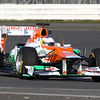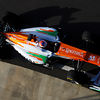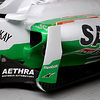Analysis: Force India unveils new VJM05

At a small launch event in Silverstone, Sahara Force India have today revealed their 2012 Formula One car, named the VJM05. The new car, to be driven by Paul Di Resta and Nico Hulkenberg features a crocodile nose similar to the Caterham CT-01.
The new Force India is a major design departure from its predecessor, the Force India VJM04.
For starters there is the front wing, which is now a completely different design after developing the same wing for 2 years. While the trailing end of the endplates are certainly interesting and completex, perhaps the most curious feature is the shaping of the leading edge of he wing's flaps.
As these are now profiled, they overlapped the base plane of the wing. To resolve this, the team cut out the overlapping parts from the base element, making it now smaller than ever. This could well provide aerodynamic benefits, but it will almost certainly enable the designers to make the front wing flex a little bit more under high loads.
With two large pillars, similar to what can be seen on both last year's and this year's Ferrari, the wing is connected to the crocodile nose. The team continued with a Red Bull-alike rounded bottom of the nosecone and monocoque to allow as much air as possible to flow under the car.
The sidepods still feature the same sidepod panel alongside the inlets, but now feature a dramatic undercut, further reducing drag that is induced by the sidepods.
At the top of the car, the team also dropped the blade design and went for a more traditional airbox. The new design however features a large undercut, requiring additional supports to make sure the rollbar is strong enough to protect the driver in case of a crash. Many teams are going this route since a few years, and it is not unthinkable that the structure incorporates metallic parts, just like LRGP have done in 2011.
Towards the rear, the car retains the pull rod rear suspension. The new exhausts are positioned where they were expected to be, fairly close to the centre of the car, and blowing in an upward angle. This was expected to be seen on many cars at introduction time, but Ferrari and McLaren have already shown that several variations are possible.
The launched car also features a small central winglet atop of the beam wing, but it remains to be seen whether this will be run on all circuits, or only on the higher downforce ones as many teams have done in the past.







